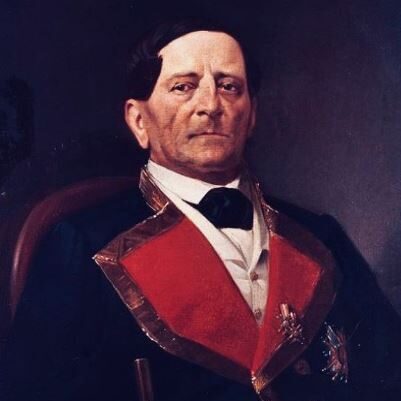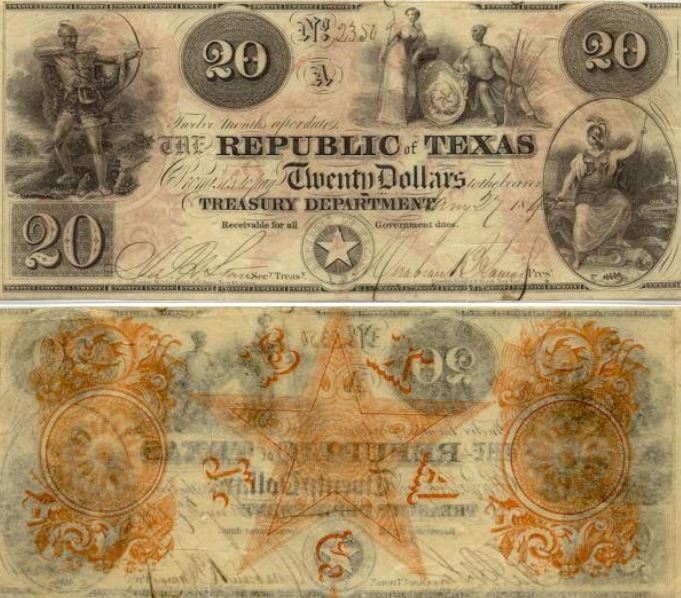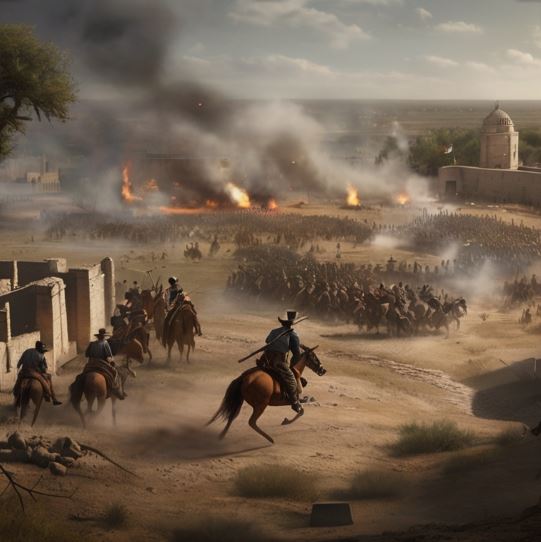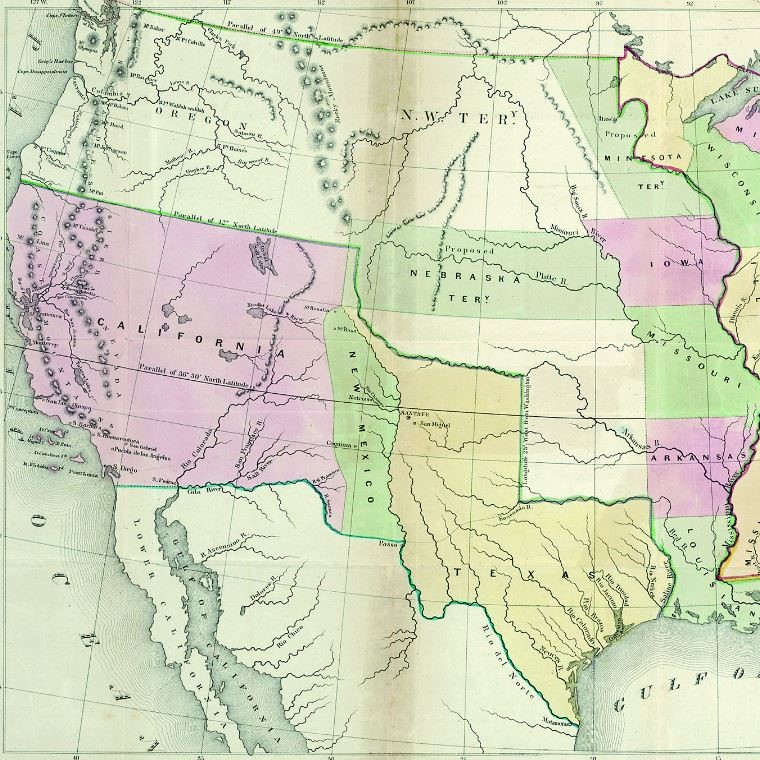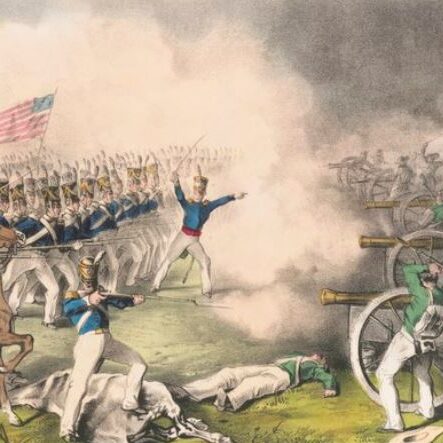The Texas Revolution, from 1835 to 1836, pitted American settlers in Texas against the Mexican government. Tensions rose over cultural clashes and disagreements about slavery.
Against all odds, the Texans fought for independence. In a surprising turn of events, a ragtag Texan army would ultimately defeat a much larger Mexican force.
Texas achieved victory over the Mexican army during the Texas Revolution through a combination of strategic decisions, determination, and key military engagements. Read on to find out more about how did Texas beat the Mexican Army.
- 1. How Texan Defensive Tactics Helped Win Independence
- 2. Leadership in the Texas Revolution
- 3. Texan Motivation for Independence
- 4. Local Support in the Texas Revolution
- 5. Mistakes of the Mexican Army
- 6. Battle of San Jacinto, April 21, 1836
- 7. International Support for Texas
- 8. A David and Goliath Victory
- Further Reading
1. How Texan Defensive Tactics Helped Win Independence
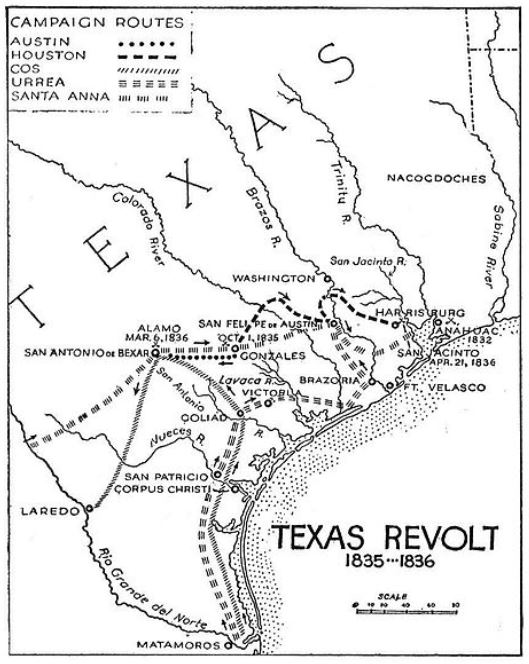
Texan forces were often outnumbered and outgunned. As a result, they relied heavily on defensive tactics to overcome these disadvantages.
Holding the Line: Fortifications and Alamo’s Stand
Texan forces understood the importance of well-defended positions. They constructed fortifications like the Alamo, a former Spanish mission repurposed as a fort.
The Alamo, despite its eventual fall, showed how these strongholds could hold off larger Mexican forces. The fortified walls and defensive layout allowed a smaller Texan garrison to inflict heavy casualties on the Mexican army.
This costly victory for Mexico demonstrated the effectiveness of Texan defensive strategies.
Knowing the Ground: Texan Advantage in Terrain
Texan familiarity with the landscape also proved invaluable. Texas is a vast region with diverse terrains, from rolling plains to dense forests.
Texan fighters were were seasoned frontiersmen and skilled hunters. They used their knowledge to their advantage. The Texans conducted guerilla warfare, launching surprise attacks from hidden positions and disappearing into the rugged terrain before the Mexican army could retaliate.
This tactic frustrated and demoralized Mexican troops, who were more accustomed to formal European battle formations.
Some notable Texan guerilla warfare events:
- Grass Fight (October 28, 1835): The Grass Fight occurred on November 26, 1835, near San Antonio de Béxar in Texas. The Texian Army intercepted a Mexican pack train, believing it carried silver for the garrison but found grass for horses instead. Despite not gaining any valuable loot, this discovery united the Texian Army and boosted their morale. It made them realize that even when outnumbered, they could prevail over the Mexican garrison at Béxar.
- Runaway Scrape (December 1835 – February 1836): Following the fall of San Antonio to the Mexican army under General Santa Anna, the Texan provisional government and many civilians fled eastward in a mass exodus known as the Runaway Scrape. During the Runaway Scrape, guerrilla tactics were employed by the Texian forces as they retreated and evaded the pursuing Mexican Army. They constantly moved and changed their positions to avoid direct confrontation with the larger Mexican Army. The Texians resorted to hit-and-run attacks on isolated Mexican units or supply lines. This strategy aimed to disrupt enemy movements without committing to a full-scale battle.
2. Leadership in the Texas Revolution
The Texas Revolution wasn’t just about settlers against a professional army; it was a testament to strong leadership. Among the figures who rose to the occasion, General Sam Houston stands out for his strategic decisions and unwavering belief in Texan independence.
Sam Houston’s Rise and Influence

Following early skirmishes in the revolution, the fledgling Texan government needed a strong military leader. Enter Sam Houston, a former governor of Tennessee with military experience under his belt. He understood the challenges Texans faced and possessed the charisma and strategic mind to unite a diverse group of volunteers.
Sam Houston’s prior experience fighting alongside Native American tribes informed his leadership style.
He emphasized guerilla tactics and recognized the limitations of a head-on clash with the larger Mexican army. He prioritized training and discipline within the Texan ranks, creating a more cohesive fighting force.
Strategic Retreats: Patience and Planning
Houston’s leadership wasn’t defined by reckless charges. He understood the importance of patience and planning.
Despite public pressure for immediate action, Houston refused to be drawn into battles where Texans were at a clear disadvantage.
He famously ordered a retreat after the fall of the Alamo. This was a decision met with public outcry but one that proved strategically sound. The retreat allowed Houston to train his new recruits, gather more supplies, and choose the battlefield most advantageous to the Texans.

This strategic retreat contrasted starkly with the actions of General Santa Anna, the Mexican president leading their forces. Santa Anna’s underestimation of the Texans and his pursuit of quick victories ultimately led to his downfall at the Battle of San Jacinto.
San Jacinto and Texan Victory
Houston’s patient leadership paid off at the Battle of San Jacinto.
By choosing the battlefield, exploiting the element of surprise, and utilizing guerilla tactics, the Texans achieved a decisive victory. This victory, a direct result of Houston’s leadership, secured Texan independence and cemented his place in history.
3. Texan Motivation for Independence
The Texas Revolution wasn’t just a military conflict; it was a clash of ideals.
Texan settlers came from a diverse group with varying backgrounds. But they were united by a burning desire for independence from Mexico.
This powerful motivation fueled their determination to fight a seemingly insurmountable force, ultimately contributing to their victory.
A Quest for Self-Rule: Clashing Cultures and Political Ideals
Texan colonists came from various parts of the United States, many seeking land and a fresh start. However, they soon found themselves under Mexican rule.
Cultural differences and disagreements over political ideals, particularly regarding federalism versus centralism, created tension.
Mexico’s abolition of slavery in Texas further alienated many Texan settlers who relied on slave labor for their cotton plantations.
These factors combined to breed a strong desire for self-rule among Texans.
They yearned for a government that reflected their values and way of life, a government that wouldn’t restrict their economic pursuits or cultural practices. This yearning for independence became a powerful motivator, fueling their fight against the Mexican government.
Standing Their Ground: Defiance in the Face of Adversity
Mexico’s attempts to suppress Texan dissent only intensified their resolve.
The Mexican government’s imposition of authoritarian rule and military actions further solidified Texan commitment to independence.
Texans were willing to defy a larger and better-equipped army because they were fighting for something fundamental: the right to govern themselves and determine their own destiny.
4. Local Support in the Texas Revolution
Texan communities, Native American tribes, and volunteers from the United States all played crucial roles in bolstering Texan numbers, resources, and morale, ultimately contributing to their success.
Texan Communities: United by a Cause
Texan settlements, scattered across a vast territory, rallied together during the revolution. Local communities provided essential support, forming militia units, supplying food and provisions to the Texan army, and sheltering refugees displaced by the conflict.
Women played a vital role, managing farms and businesses in the absence of men fighting on the frontlines, tending to the wounded, and even participating in combat in some instances.
This unified effort within Texan communities ensured the fight could continue despite the challenges.
Alliances with Native American Tribes: Strategic Partnerships
Texan leaders recognized the importance of forging alliances with local Native American tribes.
Tribes like the Cherokee and the Choctaw, who had already faced displacement and conflict with the Mexican government, saw an opportunity to push back against Mexican control.
These alliances provided valuable intelligence about the land, scouting parties, and even warriors who fought alongside the Texans.
In exchange, Texans sometimes offered safe haven or promised to respect tribal land claims in a future independent Texas.
Foreign Volunteers: A Surge in Numbers and Skills
The Texas Revolution captured the imagination of many in the United States, particularly those who sympathized with the ideals of republicanism and self-determination.
Newspapers across the U.S. spread stories of Texan struggles, igniting a spirit of volunteerism. These volunteers, often referred to as “filibusters,” brought a range of skills and experience to the fight.
Some were seasoned veterans who bolstered Texan leadership, while others provided much-needed manpower on the battlefield. Their arrival significantly increased Texan numbers, making it a more formidable force against the Mexican army.
5. Mistakes of the Mexican Army
The Texas Revolution wasn’t solely won by Texan brilliance; it was also shaped by significant mistakes by the Mexican army under the leadership of General Antonio López de Santa Anna. These mistakes, ranging from overconfidence to logistical blunders, ultimately weakened their position and contributed to Texan victory.
Underestimating the Texans
Santa Anna entered the conflict with a significant advantage – a larger, better-equipped army. However, he underestimated the resolve and fighting spirit of the Texans.
Early victories, like the fall of the Alamo, fueled Santa Anna’s belief in a swift and decisive Mexican triumph. This underestimation led him to make critical tactical errors, such as dividing his forces and failing to anticipate Texan guerilla tactics.
Logistical Nightmares: Supply Chains and Texan Terrain
The vast distances and harsh terrain of Texas posed logistical challenges for the Mexican army.
Supplying a large force over long distances proved difficult, leading to food shortages, low morale, and a weakened fighting force.
Additionally, the Mexican army, accustomed to European battlefield tactics, struggled to adapt to the Texan landscape. Texan familiarity with the terrain allowed them to launch surprise attacks and exploit Mexican vulnerabilities.
Cruelty Breeds Contempt: Santa Anna’s Treatment of Prisoners
Santa Anna’s harsh treatment of prisoners, including the execution of Texan defenders at Goliad, backfired spectacularly. This brutality solidified Texan resolve and bolstered their fight for independence. The rallying cry “Remember Goliad!” became a powerful symbol of Texan defiance.
Santa Anna’s actions not only fueled Texan anger but also alienated potential allies within Texas, including Tejanos (Texans of Mexican descent) who might have otherwise remained neutral.
6. Battle of San Jacinto, April 21, 1836

The Battle of San Jacinto was fought on April 21, 1836. This battle marked the final and decisive battle of the Texas Revolution.
Led by General Samuel Houston, the Texian Army engaged and defeated General Antonio López de Santa Anna’s Mexican army in just 18 minutes.
Texas defeated the Mexican army at the Battle of San Jacinto through a combination of strategic decisions, tactical maneuvers, and a bit of luck. The key factors that contributed to Texas’ victory included:
- Surprise Attack: General Sam Houston led the Texian forces in a surprise attack on Santa Anna’s camp near the San Jacinto River. The element of surprise caught the Mexican army off guard. The Mexican army was disorganized during the battle due to conflicting orders from Santa Anna and other leaders, leading to confusion among their ranks.
- Short Battle Duration: The battle lasted only 18 minutes, catching the Mexican forces unprepared and leading to chaos among their ranks.
- Texian Motivation: The Texians were highly motivated due to previous defeats at the Alamo and Goliad, which fueled their determination to win this decisive battle.
- Strategic Positioning: Houston positioned his troops strategically, using wooded areas for cover and preventing any easy retreat for either side.
- Twin Sisters Cannons: The Texians had artillery support from the Twin Sisters cannons, which played a crucial role in breaking down Mexican defenses.
- Capture of Santa Anna: After defeating the Mexican forces, capturing General Santa Anna himself played a significant role in securing Texas’ independence as it allowed for favorable peace negotiations.
The battle resulted in a Texian victory, Santa Anna’s capture and subsequent signing of peace treaties that paved the way for Texas to become an independent country.
The aftermath saw significant political changes and military strategies that shaped the future of Texas.
7. International Support for Texas
The Texas Revolution wasn’t just a local conflict; news of Texan resistance spread internationally, capturing the imagination of people abroad. This international spotlight, though not direct military intervention, played a crucial role in bolstering the Texan cause.
Many European nations, particularly those with republican ideals, saw parallels between the Texan fight for independence and their own struggles against monarchies.
This international attention put indirect pressure on Mexico. Negative press coverage and potential recognition of Texan independence by other nations became a concern for the Mexican government. The potential for foreign intervention, even if unlikely, also factored into Mexico’s calculations.
8. A David and Goliath Victory
The Texas Revolution stands as a testament to the power of a determined people overcoming seemingly insurmountable odds.
Texan victory wasn’t a product of a single factor, but rather a confluence of strengths and Mexican missteps.
Effective leadership, spearheaded by Sam Houston’s strategic retreats and emphasis on guerilla warfare, proved crucial in maximizing Texan strengths.
The unwavering motivation for independence fueled Texan resilience and defiance.
Tactical victories, particularly at San Jacinto, showcased the effectiveness of Texan tactics and leadership.
The Texas Revolution serves as a historical reminder that a combination of strong leadership, tactical ingenuity, unwavering motivation, and a touch of international support can overcome a larger and seemingly more powerful force.
Further Reading
If you enjoyed this article, you may be interested to read more about the Mexican-American War or Texas history.


